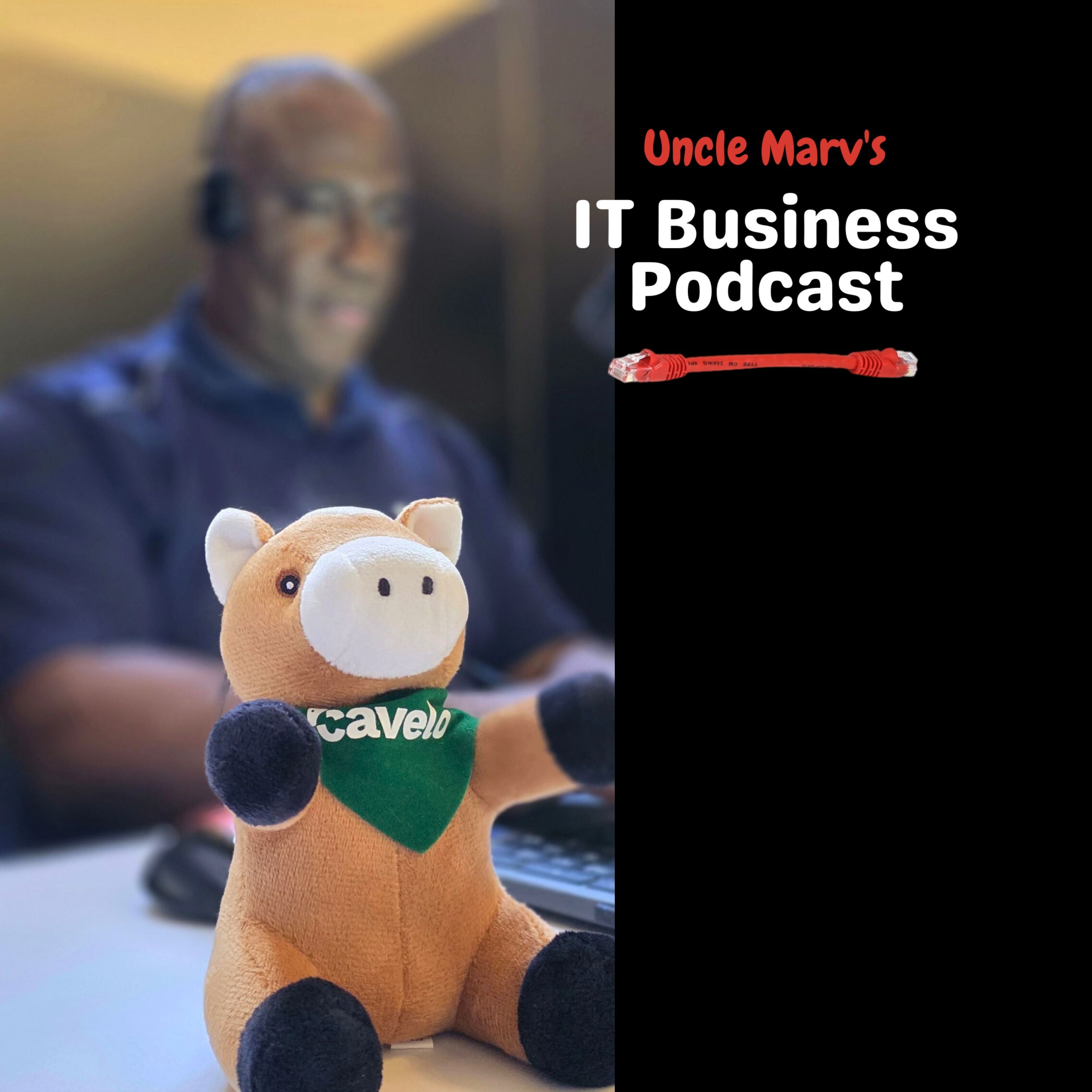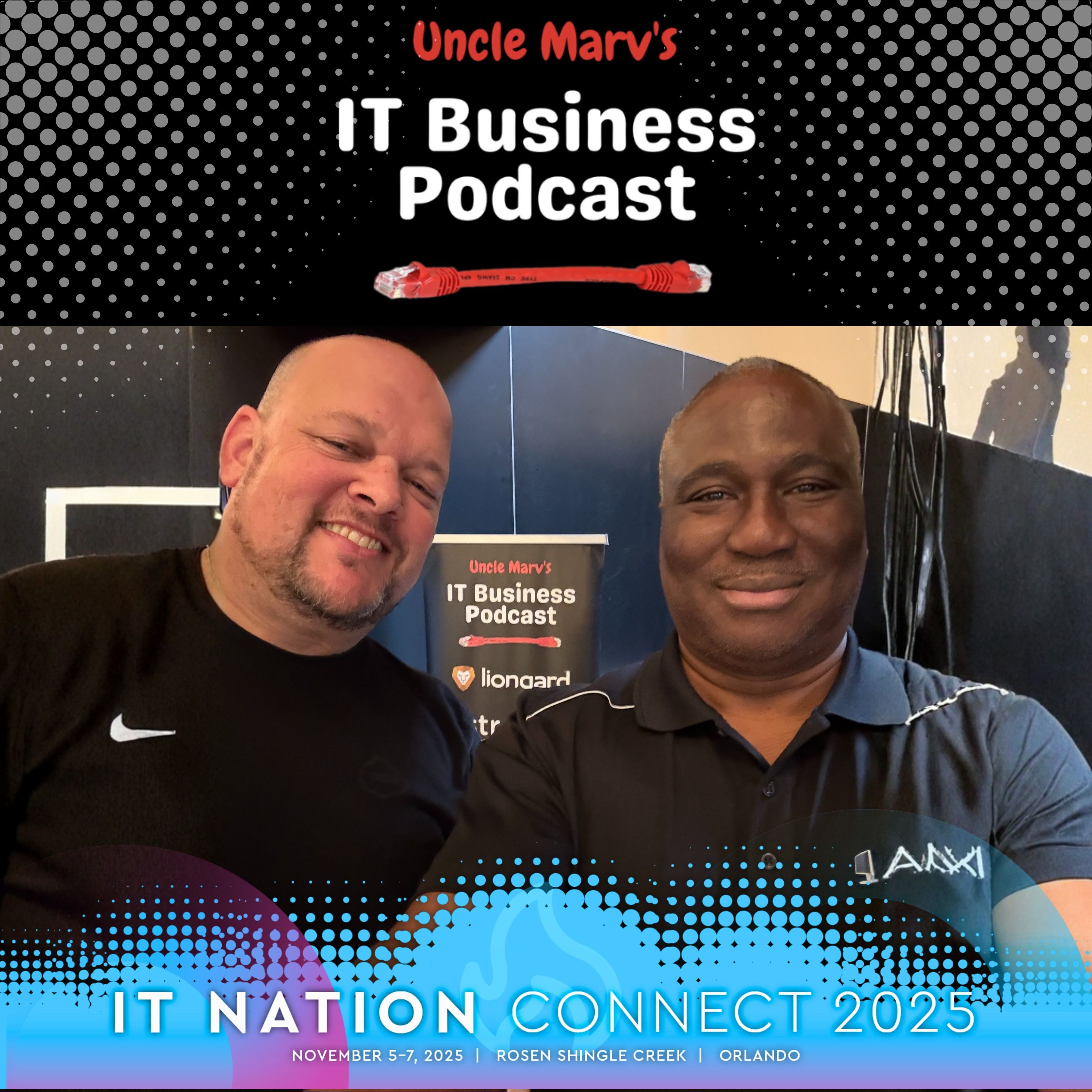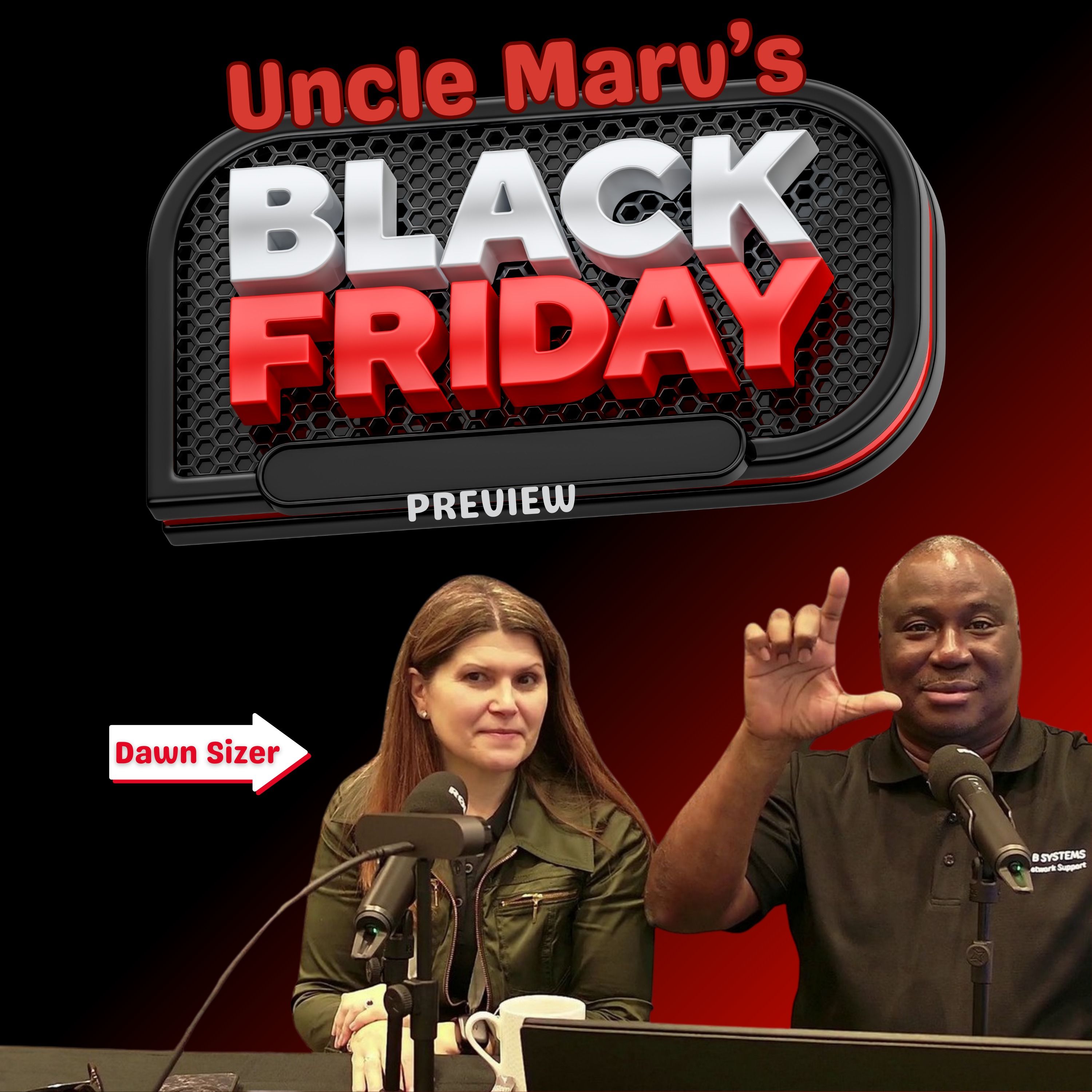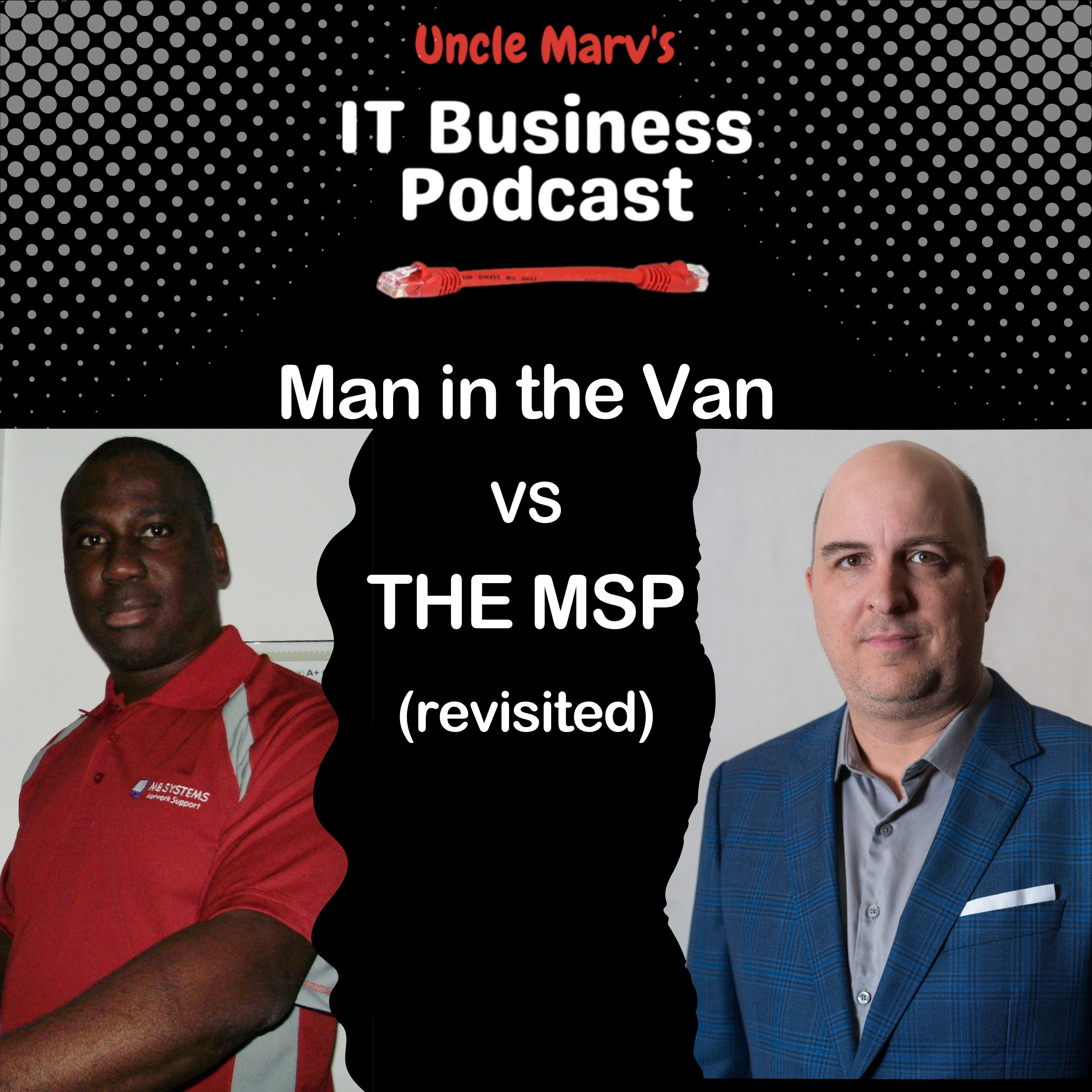676 Transforming Customer Support with Symoda

Uncle Marv interviews Wayne Creamer, founder and CEO of Symoda, about their customer-centric communication platform for managed service providers (MSPs). Wayne discusses Symoda's development, expansion plans, and the integration of AI to improve efficiency and customer support in the MSP industry.
Wayne Creamer, founder and CEO of Symoda, returns to the IT Business Podcast to discuss the evolution of their customer-centric communication platform for managed service providers (MSPs). With 20 years of experience in the MSP space, Wayne identified communication as a recurring problem among customers, which led to the creation of Symoda.
Initially a mobile-based solution, Symoda is expanding to desktop and team platforms like Slack and Teams. The platform integrates with ConnectWise and Autotask, enhancing communication and support within organizations. It offers features such as customizable push notifications, streamlined ticket management, and user onboarding processes.
Wayne emphasizes the importance of effective communication in managing customer relationships. Symoda’s push notification feature allows for targeted communication with customers, helping to resolve issues quickly and improve satisfaction. The platform aims to enhance communication at all levels: end-user, MSP contact, and VIP support.
The discussion also covers Symoda’s progress since last year, including the addition of a free customer option with marketing material, training, and a one-person trial. Wayne mentions plans for future integrations with other tools like Zendesk, Freshdesk, Halo, and Simot, aiming to make their solution end-user centric and adaptable to different tool changes.
Artificial Intelligence (AI) development is underway at Symoda, with the goal of improving efficiency and providing personalized support options. Wayne shares insights on building customer trust, personalization, and the value of feedback in product evolution.
Key Takeaways:
- Symoda addresses communication challenges in the MSP industry
- The platform is expanding from mobile to desktop and team platforms
- Integration with ConnectWise and Autotask enhances communication and support
- AI development aims to improve efficiency and personalized support
- Effective communication is crucial for managing customer relationships
- Symoda offers customizable push notifications and targeted communication
- Future integrations planned with various tools to increase adaptability
Website: https://symoda.com/
=== Show Information
Website: https://www.itbusinesspodcast.com/
Host: Marvin Bee
Uncle Marv’s Amazon Store: https://amzn.to/3EiyKoZ
Become a monthly supporter: https://www.patreon.com/join/itbusinesspodcast?
One-Time Donation: https://www.buymeacoffee.com/unclemarv
=== Music:
Song: Upbeat & Fun Sports Rock Logo
Author: AlexanderRufire
License Code: 7X9F52DNML - Date: January 1st, 2024
[Uncle Marv]
Hello friends, Uncle Marv here with another episode of the IT Business Podcast powered by NetAlly. And we are here with a vendor spotlight for the IT Nation Pitch It program. And we have a returning vendor from last year, Symoda, a customer-centric communication platform designed specifically for managed service providers to improve their interaction with end users.
And speaking with me today, the founder and CEO, Wayne Creamer. Wayne, how are you?
[Wayne Creamer]
I'm doing great, Marv. Thanks very much for having me today.
[Uncle Marv]
Well, thank you for coming back. This is your second year being a part of Pitch It. So that means you must have loved it last year.
[Wayne Creamer]
It was awesome last year, meeting everybody, all the vendors who were part of the program, all the mentors, all the great information, all the support. It's tough to get started in any sort of industry, but the way that the channel and everything is set up here and the support that you get from organizations like ConnectWise is phenomenal. It just really helps bring everything together.
So it was great.
[Uncle Marv]
Great. So I have to imagine that when people learned about what your platform does, you probably got a big rush of MSPs to say, hey, how can we take what you have and put it into our stack?
[Wayne Creamer]
Yeah, definitely, indeed. People love the idea of communicating better with their customer base. It's the one area where I feel that as an industry, we probably got a little bit complacent over the last five to eight years.
We've got very caught up with everything that's going on. We're constantly trying to protect our customers, make sure that everybody's up and running. So being able to communicate with them at a different level in a more modern way definitely is a huge, huge factor when people come to talk to us.
[Uncle Marv]
OK, so let's go ahead and expand on what I mentioned earlier about what Symoda is for people that do not know who you are and what you do. Give us a quick rundown.
[Wayne Creamer]
Indeed. Just so everybody knows, I personally have over 20 years’ experience in the MSP space. I'm a previous MSP partner based out of Canada.
We sold a private equity approximately three years ago. I went in there, everything that we would sit down and we brought the lessons that we learned from that business to what we're building here today within Symoda. High level, when I would sit down with any customers and understand what some of their issues were, nine times out of 10, it always came down to communication.
And it wasn't a case that we weren't communicating well when it came to major issues or projects or anything like that. It always came down to the fact that it was a day to day communication. It was the what's happening with this issue?
Why am I having to follow up? And then it was the over and back and the ping pong and trying to solve problems. So that's where we really created this solution.
And we started as a mobile based solution initially. We're currently in the process of bringing that to the Windows desktop and we're going to bring it to Teams and Slack this year as well. And we just try and give people that overall feeling that they've got a great communication piece with the MSP while bringing the MSP's branding all the way to them.
And on the mobile side of things, we actually bring that branding all the way to the tile of the app on their device. So when they get a push notification from us, they see your logo and understand that that information is coming from you.
[Uncle Marv]
All right. So is this just a communication platform where you're, you know, sending messages back and forth, giving them updates on their tickets or can it do more?
[Wayne Creamer]
Today we are a fully integrated solution into ConnectWise. We also do Autotask and some other PSAs are on the way. And basically we interact directly with the ticket.
So we're preventing the technician at the MSP having to spend a lot of time communicating over and back. So we synchronize that information back. But what we give today to the technician is the ability to be able to get quick communication out to that end user or the person who's currently having the problem.
So we've got push notifications, which are fully customizable by the MSP. So you can ask questions like, can I reboot your machine? They can quickly turn around and respond quickly from the device to say yes or no.
So it makes that whole process a lot easier, with a lot less friction and allows people to be able to communicate a lot better. With that, we also onboard your contacts. So if you're bringing on a new organization into your environment, as users log into our system, we now bring them through an onboarding process.
So they understand how to get access to support. They get created within your system. And so you've got the correct contact information that's in there.
By utilizing our solution, they also know straight away, you know straight away who that person is, how they need to get support and how to get back to them. And then also we use our push notifications to authenticate end users. So you're able to use that to confirm that they are the person who's at the end of the phone.
You can get an interaction over and back that's outside of any other way that any third party is trying to communicate with them today. And many more features from there.
[Uncle Marv]
All right. So customers can get that interaction. Are they able to create tickets directly from Symoda?
[Wayne Creamer]
100%. So you create tickets. You can see what's going on with your tickets.
You can see who's assigned to your tickets. You can see the progress of your tickets. You can add notes to your tickets.
And you see the interactions of those push notifications over and back with your tickets. And people are able to add attachments, everything that an end user would need to do in relation to their tickets. And we've really put a focus on making our solution end user focused.
They're not big, long, technical documents for them to be able to fill out, to be able to understand exactly what's going on, to be able to get access to some help. Really our goal is to allow people to be able to create a ticket in under a minute with all the information that an MSP needs so they can get back to work and you can communicate with them in a quick manner as well. And we also help with the triage piece of that ticket too.
So we understand the priority. We bring them through a triage process that, again, makes sense towards the end user, but also brings all the correct information for the MSP on their side so they can quickly understand where that falls within their SLAs and how to respond appropriately.
[Uncle Marv]
All right. I'm not sure if I asked this question last year, but of course AI is really big this year. So I wanted to ask if there's an AI component to this in more clarification, can you kind of create an AI response so that if a user sends a request for a simple thing like a password reset or a common problem, can they get prompted for a possible solution?
[Wayne Creamer]
We're currently building that directly into our roadmap today. We anticipate using off-the-shelf AI solutions instead of building an AI solution ourselves. I think there's been too many jumps forward on those things, but our goal is really to be able to provide a personalized AI solution to your end users.
I think the industry is going to be hit by two levels of AI. I think one's going to be internal within our MSPs, how do we become more efficient with all the masses of information that are coming our way, and then on the outside for our end users and the people who are trying to get support, giving them the ability to have personalized support options, exactly like, as you mentioned, password resets. Today we actually do that within our app, not through AI, but just by guiding people and prompting them to say, hey, you selected that you have a password problem, how's about we bring you to the Office 365 website for you to reset your password yourself?
And just little things like that to be able to guide them to it so we can understand what truly works and solves their problems for them today and get them back to work. That's all they want to do. They want to get back to work and solve the problems that they have for their own customers.
That's their goal.
[Uncle Marv]
You mentioned early on that this is something that can be MSP-branded down to the app level, you said?
[Wayne Creamer]
To the tile level, exactly. We bring the MSP branding all the way to the tile, so that logo when you look at the app today. So in that way, say for instance, we have the ability to send alerts out to multiple of your customers, say if there's a large outage, whether that's weather-related, ISP-related, big issues that are going on.
So you can notify people very quickly and let them know that there's some pieces that are being affected within their environment today. And with that, they can see your logo. So they understand as that push notification comes through, that little piece there, they can see that MSP's logo there, not just some sort of tailored system that may or may not make sense to the end user.
They may or may not know what it is. But then also having the ability to bring those push notifications to allow people to interact with them as well. So whether that's yes, no's, or to get other information that's out there, it's huge.
It's one of the big features that MSP's love today who are currently on the platform.
[Uncle Marv]
All right. I'm going to ask one of those dig deep type of questions because the push notification sounds fantastic to be able to send out an alert to everybody. I know that some MSP's only have certain users that they would send those alerts to an organization.
Others would just send out everything to everybody. Can you granularly control that? Because even in some cases, I'm going to say this gingerly, that some companies don't even allow regular end users to submit a ticket.
It's got to go through a manager or an HR department or something first. So are you able to granularly control what gets sent out in, say, a global notification?
[Wayne Creamer]
I love that you just asked me this question because we're literally releasing this this week. And we didn't even set this up, Mervyn. I love this.
100%. So when we first started describing and creating our solution here at Symoda, we know that there's three layers of communication that always are. If you're able to do really well at those, you will always have the best relationship with your customers.
And it was apparent to us across our years as an MSP here in Ottawa and Canada that we had that best relationship when all those three layers were there. So you got your end user who needs ad hoc support, whether that's from a change that we've made in the environment, whether that's from just general issues that have happened. They want to know.
They kind of want to know that Domino's Pizza app version of, is it in progress? Is it in the oven? Is it coming along?
I know that I didn't just send this into a black hole. And then only for the fact that I pick up the phone and call you that I find that there is a response. Then you've got that next layer, and that next layer is exactly what you just talked about.
That's that person who, as an MSP, we're contacting all the time. We're asking them, hey, can we reboot these servers in your environment or can we bring this application down? There might be other pieces that we have to confirm that, do we have the ability to work on this ticket for you?
There might be a cost associated, or there might be additional software licenses that are there. And then you've got that third level, where you've got the VIPs, the CEOs, the people who want that element of white label, white glove support that comes directly. Whether that brings it directly to people within the team, or they get a kind of a smaller kind of broken down version of what that is.
Maybe it's just a microphone for me to scream into to let you know that I've got a problem and I want you to fix it. But yet, you get rid of the screams. That scream doesn't arrive.
It only just arrives in words. So it makes it a lot easier for the technicians to deal with.
[Uncle Marv]
But it still could be in all caps though, right?
[Wayne Creamer]
It can be in all caps, indeed. But if you think of that middle layer, that's what we've just brought our push notifications to now. So now a technician, if they get a ticket, they can look and say, hey, I need approval for this ticket.
So now I can actually send that push notification, not just to the person who's associated, but to someone else within the organization. They can sign off from that to determine, hey, can I actually work on this? They can get it quickly on their phone, approve, yes.
Instead of having that over and back of, oh, I didn't hear, we didn't get anything back. And just stuff being stuck and not moving forward. It's a major issue.
That ping pong is a huge part of the communication problems that we have. But also as well, we got to remember that end user, that person who sits and plays that role in that environment, they're busy as well. They're not just that person who was picked just because of the fact that they've got some IT skills and they've got all this free time to do it.
But they're probably doing a multiple and wearing a multiple different hats within that organization. So having the ability for them to be able to give quick responses back, see what's going on, understand what's happening on the tickets. They get to see a history of the ticket as well.
They get to see the history of the approvals on those tickets as well. So they can help guide that moving forward. And we're also bringing that to be the VIP kind of piece as well.
So if you think of if you're working with organizations where particularly law firms is where it actually stemmed from for me, was where you might need to get to the main lawyer, but he's or she is going to be surrounded by people who are supporting them. So you can't actually get true to them today. And so you might need to have that secondary person to confirm, hey, can we remote onto the machine?
Hey, can we do all these different things and get those people to be able to be part of that network and go, yep, you can and then you go. So that's really what we're trying to do. We're trying to build that communication platform that sits in all of those layers so that every single layer within that customer that you're supporting feels that they're being communicated with at the level that they need to be communicated with.
[Uncle Marv]
All right. Well, sounds like you guys have done a tremendous job of adding stuff on since last year. I know that MSPs that want to get started, I believe, do you still have the one free customer option that.
Nice.
[Wayne Creamer]
We do indeed. We're happy to jump on, get everything set up. We fully believe within the solution that we provide today.
And we provide marketing material as well. So there's how to guides. We white glove training your technicians all as part of that one person free trial.
And because we know fine, well, that's that those end users are going to love it. And then from there, you're free to deploy that to as many customers as you want.
[Uncle Marv]
All right. I know that you said you're fully integrated with ConnectWise and Autotask. Does this work for Yahoo's like me that aren't using one of those platforms, might be using another or for a smaller MSP that might not be using any ticketing solution?
Can they still utilize Symoda?
[Wayne Creamer]
So today for people who don't have a ticketing solution, no, but we are looking to anticipate the ability to have a light ticketing system kind of at that back end to help and just to do the basics for them and use our front end to be able to do all those process flows of communication over and back. One hundred percent, we are open to creating integrations with as many other tools as are out there. We're currently just about to finalize a Zendesk and Freshdesk will be in there.
We're also looking at Halo and anybody else that's out there to make sense. We want to, we anticipate Symoda being that front end of communication with your end user. And sort of that way in time, it doesn't matter what solution you grow to, whether you grow eventually in time from Zendesk to manager to any of the other tools that are out there that your customer will always have an end user centric solution and that you can plug and play and make those changes in the back end yourself on the other side.
[Uncle Marv]
All right. There you have it. Very nice, Wayne.
Well, thank you very much for spending some time with me again. I, of course, wish you luck the second go around and look to see you in Orlando in November as part of the final three. And of course, you know, first and second place, get money.
Third place, a set of steak knives.
[Wayne Creamer]
I'm for the steak knives. That's what I want.
[Uncle Marv]
I like to hear that. All right, Wayne, is there anything else you want to have people know as they go out the door? Of course, Symoda.com.
S-Y-M-O-D-A is the website.
[Wayne Creamer]
Yep. You can check me out on LinkedIn. I'm happy to share any of the experiences I've had over the years.
But also, I think one thing that I want people to know is that we're building a solution in MSP's hands. We're not just going to come out to you and say, here's how you do it. Here's how you implement it.
And off you go. The relationship with our customers is very important. We spend a long time within this industry trying to get our customers to trust us, to understand everything we do.
And we're here to augment that so that you can build and maintain that trust with them. So they understand the value of everything that you're providing them. And then we want to be able to build things that just make it easier and get your feedback and continue to evolve this product.
Because I think, as I mentioned a little bit earlier on, the personalization of AI for that end user is going to be not only a great solution for them, but I think in time actually will be a great way for solving all the noise and workloads that come our way.
[Uncle Marv]
All right. Sounds like a great solution. And I wish you luck going forward.
And we'll hope to chat with you soon at the end of the year.
[Wayne Creamer]
Sounds good, Marvin. Thanks very much again for having me.
[Uncle Marv]
All right, folks. There you have it. Wayne Creamer, Symoda.
Check them out. There will be a link in the show notes. And of course, they'll be around all summer for the PITCHIT program.
Thank you for listening to this episode. We'll be back with more vendor spotlights throughout the summer. And of course, you can always check out the other podcasts that we have.
Head over to itbusinesspodcast.com, select your favorite pod catcher, and listen whenever we release a show. That's going to do it for now. We'll see you later.
And until then, Holla!












































